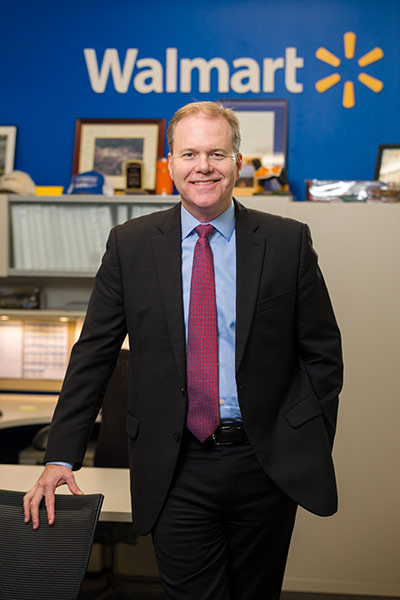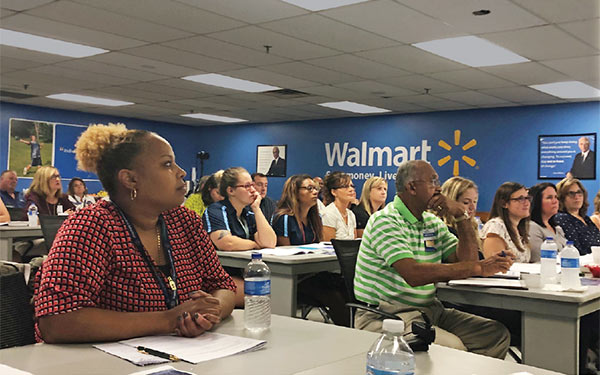By PDJ

Greg Smith is executive vice president of Walmart’s vast supply chain network for both its brick-and-mortar and online businesses. In this role, Smith leads a team of more than 115,000 associates who work in 200 facilities across the country. Read on to learn why this leader champions diversity and inclusion and how he has brought that conviction to his role at country’s largest private employer.
PDJ: You’ve come to be known as a strong champion and advocate for diversity and inclusion within Walmart. Let’s start by learning a bit about you and why advancing diversity and inclusion is important to you personally.
First of all, I have to acknowledge that I am answering this question as a white male and while the importance of diversity and inclusion feels deeply personal to me, it cannot compare to the personal feelings and experiences of others with more diverse backgrounds.
That said, my thoughts on diversity and inclusion began as a young boy growing up in the segregated South. Segregation was a hot issue in our small town. Many of my friends were beat up just because they looked different than me. My father grew up in a military family that exposed him to different cultures around the world. He didn’t believe in the segregation of our African American community members and knew that all people, regardless of the color of their skin, should be treated equally. I’m grateful for my father’s positive influence.
Throughout my career, I’ve been fortunate to see a lot of the world just like my father did. When you leave the U.S., you quickly learn that people are just people, and our differences are something to appreciate and celebrate. It’s those differences that challenge our thinking and help us grow as individuals and as teams.
All of that has come to shape my commitment to diversity and inclusion. I know for a fact that I’m not better or smarter than anyone on my team. As a people leader, it is my job to foster an environment where everyone feels engaged and empowered to be themselves at work – because of their unique perspectives and backgrounds, not despite them. And that job is never done. It’s something I continually work on.
PDJ: Tell us a little bit more about your leadership philosophy and how it has developed.
When I was 22 years old, I had a profound experience thanks to my very first corporate mentor. I was put in a supervisory role responsible for 25 people, most who were at least twice my age and who had more experience than I could ever hope to achieve at that young age.
My mentor, who was a full two levels above me, sat me down and told it to me straight. “Look, son, you’re never going to be able to learn the skills and knowledge that your team of 25 already has accumulated. So don’t even try. You don’t need to focus on what they know. In the capacity of a supervisor, you only have one job: unlock the power of your people.”
The truth of what he told me hit me like a ton of bricks. That day, I realized something that has stayed with me throughout my career: It’s not about what I do. It’s about what my team does – and how I support those efforts – that makes all the difference. By helping my team be engaged, enabled and empowered, we all deliver at our highest potential. My job is to set the vision, increase capabilities, and to remove the roadblocks and obstacles that stand in their way to unlock their own true potential.
The three Es (engaged, enabled and empowered) are foundational to my leadership style and it’s something my leadership team focuses on with our team. It’s a culture we have the power to create as leaders, and that culture is where diversity and inclusion can thrive. When the workplace is diverse and everyone feels included, we have stronger teams and the business benefits.
PDJ: In order to provide context for our readers, what are some of the unique diversity and inclusion opportunities that the logistics and supply chain industry faces broadly and how do these directly impact the organization you lead at Walmart?
As Supply Chain began emerging as a critical functional capability in the 1980s and 1990s, the pipeline of talent – often coming through the manufacturing, engineering and distribution functions – was not very diverse. Over the course of my career, I’ve noticed a prevailing mindset – almost an excuse – that Supply Chain doesn’t have to be diverse because there isn’t a sufficient pipeline of diverse talent available. In 2020, that simply isn’t true. The data shows that many of the best in class Supply Chain universities are graduating highly diverse and highly capable talent, and it is simply incumbent upon us to ensure that we are recruiting strategically and casting a broad enough net when we recruit top talent at all levels of the organization.

PDJ: Why is diversity and inclusion so important to Walmart?
When it comes to diversity and inclusion, it’s important to mirror the communities in which we operate. In order for us to be the best retailer, we need to reflect our customer base. And with nearly 160 million people shopping with us each week, our customer base represents all of America. We still have work to do on that front, but it’s something we are working on as a company.
A diverse workforce is also more innovative, better at problem-solving and frankly delivers better business results. I believe the power of different people with different perspectives gives me a better solution versus being myopically surrounded by people who think the same way as I think.
PDJ: How does a company the size and scale of Walmart approach diversity and inclusion strategy?
At Walmart, we have a team, called our Office of Culture, Diversity & Inclusion, that focuses on helping our leaders and associates create an inclusive culture where all associates are engaged to deliver on our purpose of saving people money so they can live better. We intentionally think of diversity and inclusion in the context of our corporate culture because the Walmart culture is universal around the globe – from Bentonville to Shenzhen to San Bruno to Mexico City. The rationale is that if we integrate diversity and inclusion into the Walmart culture, we can operationalize it in such a way that it becomes an inherent part of our global DNA.
The team’s work is driven by data and each business unit, including Supply Chain, works with the team to develop an action plan unique to the area based on insights from the data that addresses relevant focus areas across the talent life cycle.
PDJ: What are some of the initiatives and programs that you and your leadership team have implemented within Walmart’s Supply Chain organization which have made a noticeable impact on diversity and inclusion results?
We’ve really tried to come at diversity and inclusion from all angles through a comprehensive strategy with four pillars (hiring/promotion, recruiting, education and environment).
We now require diverse slates of both candidates and interviewers for all open positions at the director level and above, and we regularly review and track diversity metrics at leadership meetings. Our team’s inclusive education plan offers field and corporate office managers a variety of training opportunities and interactive learning experiences on how to lead a diverse team, role-model inclusive behaviors and fight implicit bias during decision-making. We also formed a women’s leadership council to champion the development of our female talent within the supply chain organization and launched Lean In Circles as a mentoring platform.
One of the most impactful things we did as a leadership team was participate in a two-day Men Advocating for Real Change (MARC) immersive workshop. For those unfamiliar, MARC, led by Catalyst Inc., helps participants better understand the dynamics of privilege and how awareness by majority groups about the presence and effects of privilege could create a more inclusive environment. The purpose of this workshop was to focus on gender equality in the business world, how it is crucial to the success of businesses with regards to morale and productivity in the workplace, and how each of us could better understand equity and equality for all. All of the Supply Chain senior leaders attended the training, so it was a big investment for us, but we all walked away better equipped to champion diversity and inclusion on our team.
Personally, I participate in our company’s sponsorship program, which matches top talent with executive leadership as their advocate to fast track their career success. Of the 18 in my group, more than half are female or people of color.
I’m so proud of the strides our team has made in the last few years, but I know the work will never be done. There is always more to learn and room to grow, and that’s the mindset I try to create.







